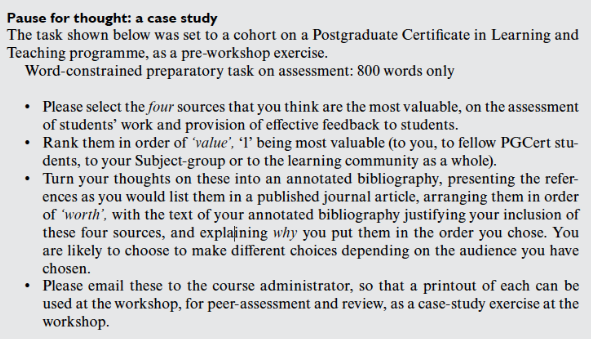An annotated bibliography assessment task provides an alternative to a conventional essay.
Advantages and limitations
- Promotes reading, research and understanding.
- Promotes deeper learning on topics analysed for the bibliography.
- Completed assignments can provide useful learning resources for future cohorts in the subject.
- Collaboration and collusion can be readily identified.
- Use of specified sources as the basis of the task can streamline marking.
- Demonstrates referencing skills.
- Develops professional practice skills that are readily transferable to the work context.
- Aligns with learning outcomes and cognitive processes related to interpreting sources, review and analysis, critical thinking, comparing and contrasting, evaluation, judgement, reflection and academic writing.
- Students require information literacy skills.
- Use of excessive numbers of sources limits student ability to demonstrate depth of thinking.
- Unfamiliarity with this assessment type may indicate the need for in-class practice.
- Delivering feedback about choice of sources can be challenging.
- This is one of the many recognised forms of assessment that are targeted by contract cheating services
Some considerations
Ref: Race, P. (2020). The Lecturer’s Toolkit (5th ed.), pp. 86-89. Routledge: Abingdon.
- Ensure the topic is aligned with learning outcomes and subject content.
- Set limits on the word count and the number of sources to be included.
- Be clear about the types and number of sources that are permissible, such as journal articles, books, blogs and other web sources, magazines.
- Specify some of the sources to be reviewed and provide free choice about other sources.
- Be clear about the prioritising of the resources.
- Choose appropriate word limits for the level of study.
- Can limit the range of content that can be assessed and the number of assessment items that can be used.
Additional resources
Sample annotated bibliographies:
- Annotated Bibliography IKC100 – see DLT Example Rubrics webpage. International Relations; Environmental Science sample annotations – Australian National University.
- This sample is from Race, P. (2020). The Lecturer’s Toolkit (5th ed.), pp. 88. Routledge: Abingdon. Available online through Charles Sturt University library.

- Understanding Historiography through an Annotated Bibliography - Duncan, J., & Lundstrom, K. (2014). Understanding Historiography through an Annotated Bibliography: Scaffolded Learning for a Capstone Research Project. Utah State University. Retrieved from https://www.learningoutcomesassessment.org/assignment-library/understanding-historiography-through-an-annotated-bibliography-scaffolded-learning-for-a-capstone-research-project/ on April 14, 2020.
Instructional and assessment resources
The following resources are for students and are useful as instructional resources. They also provide guidance in terms of designing a literature review assessment:
